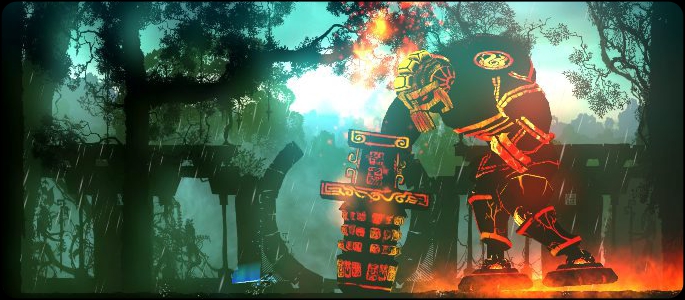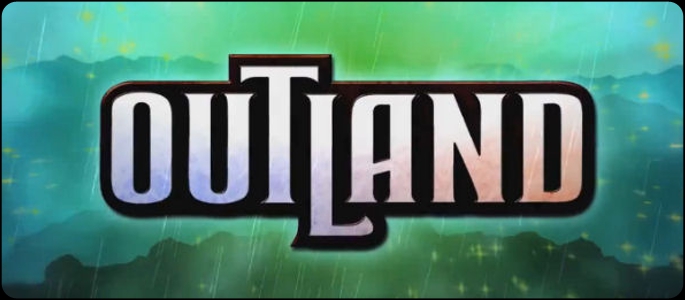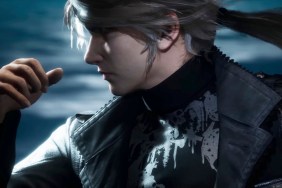The PSN has a lot of great titles, and plenty of developers capable of producing high-quality gaming experiences. Housemarque was one of the first developers to release a game on the PSN with the amazing Super Stardust HD. Since then, Housemarque has developed Dead Nation and Outland. Keep reading after the jump to find out if Housemarque’s latest game, Outland is worthy of a purchase.
Outland is a 2D action-platformer in the style of games such as Castlevania and Metroid. Your goal is to traverse the levels defeating enemies, acquiring new powers, and collecting gold for upgrades. The main feature of Outland is the ability to shift the character from red to blue energy levels. Much like the top-down shooter Ikaruga, players will need to make sure their character is in the right energy level to get past obstacles and defeat enemies.
First, let’s start with the visuals, since that is the first thing anyone will notice. This game is beautiful. The background of the levels are stacked with silhouettes and images of nature that are really breathtaking. There are several different stages you can visit and each one has a different theme. There is an ice world, a desert world, and so on. The color scheme will change as you move from level to level, for example, the first world has a lot of green in the background, while the desert world has a lot of yellow in the background. Every level feels unique and players easily get a sense that they are moving through a carefully crafted world. Housemarque has also done a great job with their character and enemy models. Enemies are flat, black shapes with either red or blue color streaks throughout their body. Imagine as if the enemies are wearing Tron suits. This makes enemies very easy to spot since most of the backgrounds in the game use soft, pale colors. It also makes your own character stand out well, and when you change between red and blue energy levels there will be a bright flash to let you know. This comes in very handy, as you will often have to change between energies several times to get past some obstacles.
Outland plays like a Castlevania style 2D platformer; the levels are non-linear, you can go anywhere you want, except for areas that require a special ability to access. The abilities you get by continuing the main storyline range from launch abilities, to floor stomps, to powerful punches capable of breaking walls. These areas are all throughout the game. In fact, when you first start the game, you will come across a launch pad which you can’t activate until several hours into the game. Backtracking to previous areas is made easier by the various teleportation stations that are located around the levels. Of course, teleportation needs to be unlocked like the rest of the abilities, but it is a huge timesaver for exploring. Usually, these secret areas contain pots with gold that could be used to upgrade your character, but sometimes there will be a secret skull. These skulls are scattered all throughout the game and can be collected to unlock concept art and other features. To let you know the right direction to go, there is a cloud of golden leaves that lets you know where you should be heading. It does a great job of keeping you on track, so you can quickly get through a level if you don’t want to look for secrets. Checkpoints are scattered throughout the game to save your progress. Your progress is saved only at these spots, so if you collect a secret item and die before you reach a checkpoint, you will have to collect that item again. Luckily, the checkpoints are close enough so that isn’t much of a problem.
Combat is a big emphasis of the game. You can perform basic attacks, air attacks, and ground attacks, as you would expect. Chaining together attacks is very easy, so combat flows very naturally. This makes it easy to take on several enemies at once. Players will also continue to learn abilities as they progress through the game. These newer abilities add even more variation to combat. The floor stomp will daze enemies, the uppercut will launch enemies into the air, and the slide will knock melee enemies off their feet. You can also learn special attacks that require energy to use, such as a giant laser beam. You can refill your energy gauge by defeating enemies. You start out with one use for an energy weapon, but you can purchase extra energy slots. Players can also purchase extra health. Sometimes, these upgrades for energy and health are hidden, so that is another incentive to explore.

Combat has a unique aspect. When you first start the game, your character is green and is hurt by both red and blue enemies, but for the most part, the player can switch between blue and red energies. You will need to be the opposite color of whatever enemy you want to fight to do damage. For example, if you are currently blue and try to attack a blue enemy, you will simply bounce off without doing any damage. Enemies and traps will also shoot out energy balls. The player will absorb energy beams of the same color, and take damage from energy balls of the opposite color. There are also platforms that become invisible if you are the wrong color, and will cause the player to fall through them. Towards the end of the game, it can get quite hectic with very complex patterns of energy balls being shot at the player. This is one of the game’s strongest elements. The developers have managed to incorporate a puzzle element into the platforming. Not only does the player have to be able to physically traverse very complex levels, but also plan out the route beforehand. The platforming is designed in a way to be a challenge to the player, and yet not be frustrating. In fact, you will have a blast bouncing off walls, across spike pits, and between floating enemies. Unfortunately, the hit detection right as you change from energies is a little off. Often, you will change to the blue energy, as you enter a blue energy stream, only to have your character still take damage. This becomes a major problem towards the end of the game, when the player has to navigate through complex mazes of energy balls.
As you would expect, the player will have to fight several bosses throughout the game. Bosses are cleverly designed, and have multiple stages. One boss that particularly stands out is a giant spider that shoots beautiful patterns of red and blue energy balls. Players will need to interact with the environment to take down bosses as well. For example, you might need to navigate across floating platforms or hit buttons to direct cannon fire. The main problem with boss battles is that they last longer than they need to. The bosses have a lot of health, and defeating them takes just a little too long. It’s not that the boss battles are painstakingly long, it is just that I got tired of a boss battle before it ended. The boss battle arenas also tend to be very large so the camera has to zoom out rather far from the player. This can make the character a little hard to see, especially when there are a lot of energy balls flying around. There are also mini-boss battles that occur randomly throughout levels. Like with regular bosses, a health bar appears at the top of the screen and the mini-boss is large enough to block your path. These mini-bosses are tougher than regular enemies but shouldn’t pose that much of a challenge.
The story is the weakest part of the game. In between levels, small snippets of story are revealed to the player. Sometimes it is just text with a voice-over and other times it is a short animation. The voice over work is done very well, but it would be nice if they could incorporate the story as part of the gameplay, especially since the narrator is telling the story of what the player is actually doing in the game. Having to just sit there and listen to a voice is so different from the action packed platforming that it draws you out of the experience.
On top of all this, the game features co-op support. You can play through the game with a friend, or you can just play certain challenge rooms. These challenge rooms will need to first be unlocked by finding them in the regular story campaign. As with many PSN games, there aren’t very many people who play this game online. Unless this review causes thousands of people to go out and buy the game, it will be very hard to find a stranger to play with. Since playing through the game’s single player is so much fun, it isn’t the worst news, but it is something players should be aware of. If you have a friend, then playing through Outland together will definitely make the experience a lot more fun.
Outland is a great title for the PSN. It draws from several other games for inspiration, but is able to make an experience that feels unique. Some long boss fights, and the fact that energy balls of the same color can hit you right as you change, are the only things keeping this game from being a truly great game. Outland is available on the PSN for $9.99.
PlayStation LifeStyle’s Final Score
+ Fun, Fast Combat – Inconsistent Hit Detection |
 |
–








